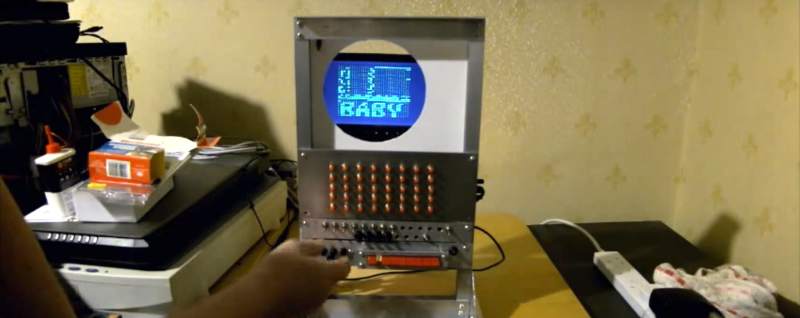The Manchester Baby seems simple today. A 32-bit machine with 32 words of storage. It wasn’t meant to be a computer, though, but a test bed for the new Williams tube storage device. However, in 1948, it executed stored programs at about 1,100 instructions per second. The success of the machine led to a series of computers at Manchester University and finally to the first commercially available computer, the Ferranti Mark I.
[Dave] is lucky enough to volunteer to demonstrate the Baby replica at Machester’s Museum of Science Industry. He wanted his own Baby, so he used a Xilinx FPGA board to build a replica Baby named BabyBaby. Although it runs at the same speed as the original, it is–mercifully–much smaller than the real machine.
Still, [Dave’s] construction is faithful to the original look and feel even though a VGA monitor replaces the CRT screen. You can see a demo of the BabyBaby in the video below. The implementation is in VHDL and–given the VGA interface–is probably more complicated than the original machine.
Baby’s instruction set is very simple by today’s standards. The only math operations available are subtraction and negation. Since a simple addition requires four of the 32 instructions, you can imagine that you can’t do anything too complex. Still, for 550 tubes that drew about 3.5 kW, it was a marvel in 1948.
Oddly enough, this isn’t the first Baby rebuild we’ve seen. There’s a scaled-down 8-bit version. We’ve even seen the Baby’s offspring–the Mark I–playing music in what could be the oldest known computer-generated music.
















can it be put in a corner?
Nobody puts BabyBaby in a 9 dimensional corner!
grow up
lift your game
Nice project. I looked at that computer https://en.wikipedia.org/wiki/Manchester_Small-Scale_Experimental_Machine a number of times when investigating minimal working computer. I calculated I might get away with around 500 transistors :) “The machine contained 550 valves—300 diodes and 250 pentodes”.
Interesting project!
That screen should be at least an analog oscilloscope with a CRT, though :)
===Jac
Or the VGA screen should show a picture of a CRT like the one in the project gallery.
I believe that screen was a mirror output of the Miller storage tube – it would be fun to see if one could be recreated using a CRT scope (on my long list of future projects)
It is a VCR97 tube, a surplus radar tube from the forties, so if you want a real tube…
I think I hacked this thing in Fallout 4 a few times..
Manchester Baby? Can I get Coronation Street on it?
The real question is how long before someone hacks it to run DOOM.